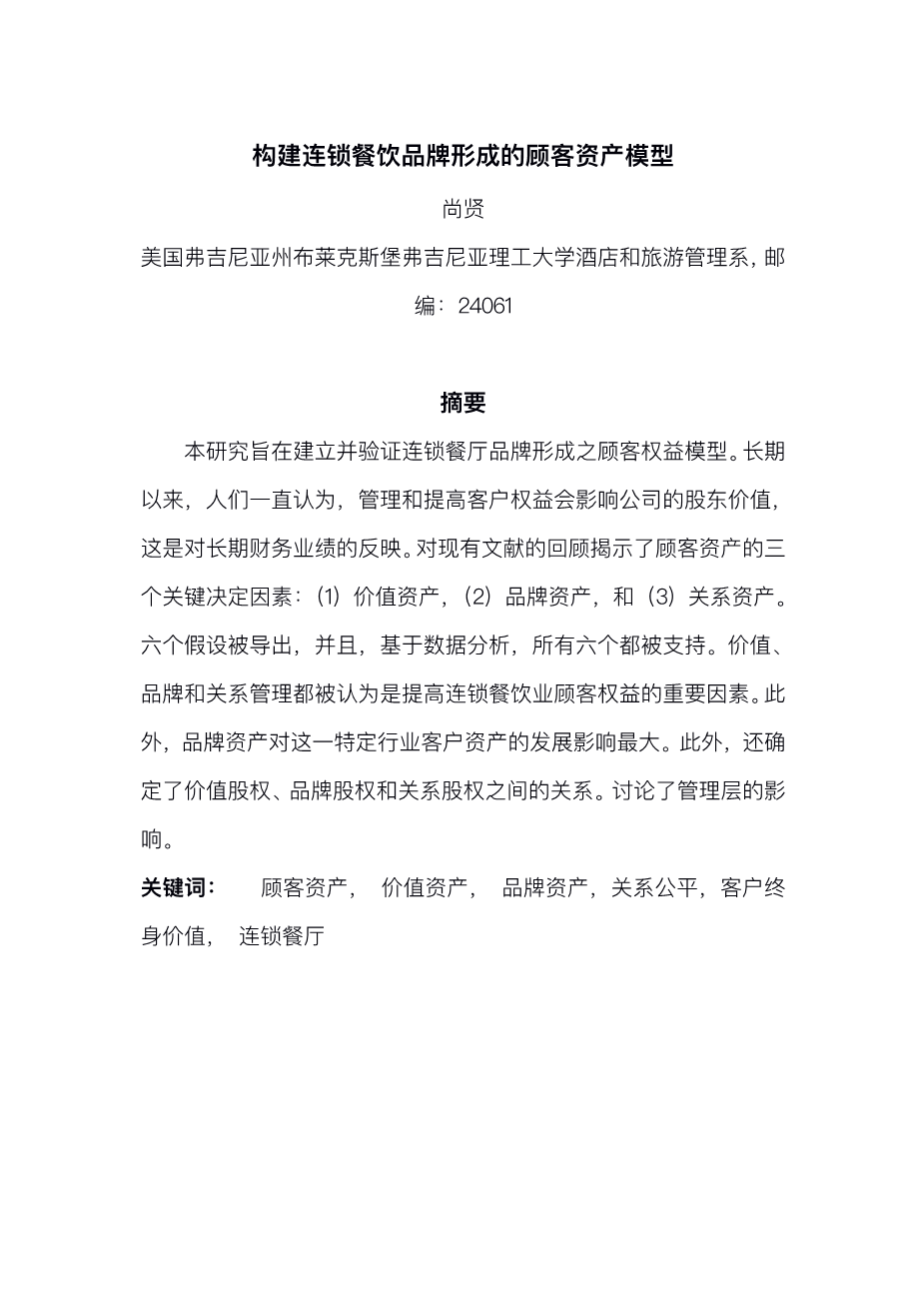Creating a model of customer equity for chain restaurant brand formation
Sunghyup Sean Hyun
Department of Hospitality and Tourism Management, Virginia Tech, Blacksburg, VA 24061, United States
ABSTRACT
The purpose of this research was to create and test a model of customer equity for chain restaurant brand formation. It has long been acknowledged that managing and enhancing customer equity influences a companyrsquo;s shareholder value, which is a reflection of long-term financial performance. A review of the current literature revealed three key determinants of customer equity: (1) value equity, (2) brand equity, and (3) relationship equity. Six hypotheses were derived and, based on data analysis, all six were supported. Value, brand, and relationship management were all confirmed to be important factors in enhancing customer equity in the chain restaurant industry. Further, brand equity has the strongest impact on the development of customer equity in this particular industry. Relationships among value equity, brand equity, and relationship equity were also identified. Managerial implications are discussed.
Keywords:Customer equity,Value equity,Brand equity,
Relationship equity, Customer lifetime value, Chain restaurant
1. INTRODUCTION
The fundamental goal of a business is to increase shareholder value (Kaplan and Norton, 1992). Shareholder value forecasts future cash flows and discounts them into an estimate of current value, representing the long-term value of the company (Rappa- port, 1986). As the business environment becomes ever more competitive, business managers need to know how various investments, including product value improvement, branding strategies, and relationship marketing strategies, relate to share- holder value increase (Day and Fahey, 1988; Rust et al., 2004). Business managers need a practical model for linking marketing investments and shareholder value.
With the evolution of relationship marketing, researchers have, in recent years, proposed the concept of customer equity as an overall measure of marketing success and the concept is directly related to shareholder value (e.g. Berger et al., 2006; Gupta et al., 2004; Rust et al., 2004; Srivastava et al., 1998; Wiesel and Skiera, 2005). Defined as the total discounted lifetime value of a firmrsquo;s customers (Blattberg and Deighton, 1996), customer equity attempts to measure customer relationship value based on not only a customerrsquo;s current profitability, but also the customerrsquo;s long-term profit value. Because of its direct financial impacts, maximizing customer equity is important to businessesrsquo; success (Rust et al., 2000).The chain restaurant industry is no exception in this regard. To maximize their customer equity, chain restaurant brands invest in various marketing expenditures, such as menu development, advertising, and relationship management.
For example, Apple- beersquo;s invests $126 million in advertising annually to improve their brand awareness and customer equity (Advertising Age, 2006). Cheesecake Factory annually spends $500,000 for menu develop- ment (Nations Restaurant News, 2006). A large number of chain restaurants, such as T.G.I. Fridayrsquo;s and Benniganrsquo;s, have developed such relationship marketing programs as frequent diner programs, the purpose of which is to build a long-term customer relationship and enhance the customer equity of the chain restaurant brand (Kim et al., 2006). However, chain restaurant owners/managers do not currently have a practical model demonstrating the link between their marketing investments and customer equity. There are a number of existing customer equity models (e.g. Rust et al.rsquo;s formula proposed in 2000) focused on calculating customer equity itself; however, those models do not provide practical link between marketing investments and customer equity. Therefore, chain restaurant owners/managers have been under constant pressure to find more effective marketing strategies that can maximize customer equity, but have no practical guidelines to do so (Doyle, 2000).
While current research clearly indicates that a companyrsquo;s customer equity is a major factor influencing long-term profit, shareholder value, and relationships with customers, our under- standing of the factors that influence customer equity is relatively weak in the chain restaurant industry. No previous study has covered how customer equity for a chain restaurant brand is formed, so there has been no agreement about the parameters of the concept of customer equity for a chain restaurant brand. It is critical to the success of chain restaurants to create a model explaining the formation of customer equity. After engaging in an in-depth literature review, this study defines customer equity for a chain restaurant brand as the total of the discounted lifetime values, summed over all of the chain restaurant brandrsquo;s customers. This study thus sought to create and test a model of customer equity for chain restaurant brand formation.
Literature review
-
- Customer equity
Customer equity is defined as the total of the discounted lifetime values summed over all of the firmrsquo;s customers (Blattberg and Deighton, 1996). Customer lifetime value is one of the most critical measures in assessing the performance of business companies (Sargeant, 2001).
英语译文共 18 页,剩余内容已隐藏,支付完成后下载完整资料
课题毕业论文、文献综述、任务书、外文翻译、程序设计、图纸设计等资料可联系客服协助查找。




